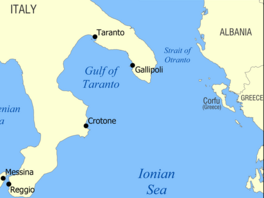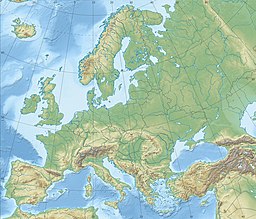Strait of Otranto
This article needs additional citations for verification. (January 2014) |
| Strait of Otranto | |
|---|---|
 Map showing the location of the Strait of Otranto | |
| Coordinates | 40°13′10″N 18°55′32″E / 40.21944°N 18.92556°E |
| Basin countries | Italy, Albania |
| Min. width | 72 km (45 mi) |
| Average depth | 18 m (59 ft) |
Vlora

The Strait of Otranto (
Italian city of Otranto
.
History
Since ancient times, the Strait of Otranto was of vital strategic importance. The Romans used it to transport their troops eastwards. The legions marched to
Brundisium (now Brindisi), had only a one-day sea voyage to modern Albania territory and then could move eastwards following the Via Egnatia
.

World War I
During
France, and Great Britain, by blockading the strait, mostly with light naval forces and lightly armed fishing vessels known as drifters, hindered the cautious Austro-Hungarian Navy from freely entering the Mediterranean Sea, and effectively kept them out of the naval theatre of war. The blockade was known as the 'Otranto Barrage
'.
However, the barrage was notoriously ineffective against the German and Austrian U-boats operating out of the Adriatic, which were to plague the Allied powers for most of the war throughout the Mediterranean.[2]
After the fall of the Iron Curtain
In 1992,
delimited the continental shelf
boundary between the two countries in the Strait. Whatsoever the administration rights over the Strait were given to Albania not changing much from the former deal of Otranto.
In 1997 and 2004, nearly 100 people died trying to illegally cross the strait following the
1997 unrest in Albania and poor economic conditions in the Tragedy of Otranto and the Karaburun tragedy
.
In 2006, the
jet boats
. In 2010, the moratorium was extended until 2013.
See also
Wikimedia Commons has media related to Strait of Otranto.
References
- ISBN 978-0-231-13242-8. Retrieved 6 March 2013.
- Dorling Kindersley, 2003, P. 186.
- ^ "Keshilli i Ministrave". Archived from the original on 2011-07-06. Retrieved 2011-02-25. Council of Ministers of the Republic of Albania, www.keshilliministrave.al, 10 August 2006.



